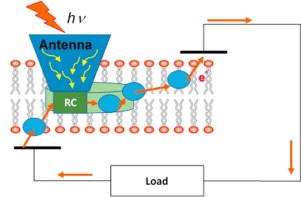Journal of Photochemistry and Photobiology C: Photochemistry Reviews ( IF 13.6 ) Pub Date : 2018-04-22 , DOI: 10.1016/j.jphotochemrev.2018.04.001 Elshan Musazade , Roman Voloshin , Nathan Brady , Jyotirmoy Mondal , Samaya Atashova , Sergey K. Zharmukhamedov , Irada Huseynova , Seeram Ramakrishna , Mohammad Mahdi Najafpour , Jian-Ren Shen , Barry D. Bruce , Suleyman I. Allakhverdiev

|
Over the last two decades many reports have been published on diverse types of biohybrid electrodes utilizing components of the photosynthetic apparatus. Currently, the development of such devices does not extend beyond laboratory research. In the future, these electrodes could be used in biosensors, solar cells, and as a new technique to investigate photosynthetic pigment-protein complexes. Efficiency of light-to-current conversion is particularly important for solar cell applications. Selection of a suitable substrate for special pigment-protein complexes is a significant challenge for building an inexpensive and efficient device. Various combinations of pigment-protein complexes and substrates, as well as different measurement conditions make it difficult to directly compare performance of various solar cells. However, it has been shown, that one of the possible substrate materials, namely nanostructured TiO2, is the most preferred material for the immobilization of pigment-protein complexes in terms of both cost and efficiency. The photocurrent values reaching several mA, were reported for TiO2-based biohybrid electrodes. However, the efficiency of TiO2-based biohybrid is still far from its potential maximum value due to fundamental challenges related to designing an optimum interface between TiO2 nanostructure and pigment-protein complexes containing electron transferring cofactors. To date, counterproductive back reactions, also referred to as charge recombination, still dominate and lower internal quantum efficiency of these systems.
中文翻译:

生物混合太阳能电池:基本原理,进展和挑战
在过去的二十年中,已经发表了许多关于利用光合作用装置的组件的各种类型的生物杂交电极的报告。目前,此类设备的开发并没有超出实验室研究范围。将来,这些电极可用于生物传感器,太阳能电池,并作为研究光合作用色素-蛋白质复合物的新技术。光到电流转换的效率对于太阳能电池应用特别重要。对于特殊的色素-蛋白质复合物,选择合适的底物对于构建便宜且有效的装置是一个重大挑战。色素-蛋白质复合物和底物的各种组合以及不同的测量条件使得难以直接比较各种太阳能电池的性能。然而,事实证明,就成本和效率而言,图2是最优选的用于固定颜料-蛋白质复合物的材料。据报道,基于TiO 2的生物混合电极的光电流值达到几mA 。然而,由于与设计TiO 2纳米结构与包含电子转移辅助因子的颜料-蛋白质复合物之间的最佳界面有关的基本挑战,基于TiO 2的生物混合物的效率仍远未达到其潜在的最大值。迄今为止,适得其反的逆反应(也称为电荷重组)仍然占主导地位,并降低了这些系统的内部量子效率。



























 京公网安备 11010802027423号
京公网安备 11010802027423号